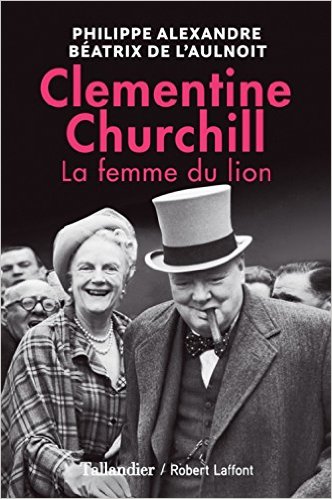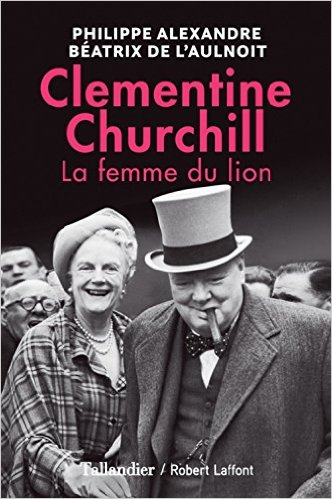
Finest Hour 172
Books, Arts, & Curiosities – Une Grande Dame

June 12, 2016
Finest Hour 172, Spring 2016
Page 42
Review by Antoine Capet
Philippe Alexandre and Béatrix de l’Aulnoit, Clementine Churchill: La femme du Lion, Paris: Tallandier / Robert Laffont, 2015, 397 pages, €21.50. ISBN 979–1021007406
 By coincidence, two new books on Clementine Churchill appeared, one on each side of the English Channel, in 2015. In addition to Sonia Purnell’s First Lady: The Life and Wars of Clementine Churchill (Aurum, 2015), the first-ever biography in French also appeared in the same year, written by two well-known journalists. The difficulty for English-language authors is to appear not to rely too much on Mary Soames’s standard life, Clementine Churchill (1979, revised 2002). But French buyers of La femme du Lion (The Lion’s Wife) are unlikely to be familiar with Lady Soames’s book, which is an advantage since the authors can—and do—draw freely from it. The intended readership is not clear—probably le grand public (the general public) since there are no footnotes. A large proportion of the book reminds one of the Court Circular in the quality press, and an even larger one of the People & Celebrities gossip columns of the popular press.
By coincidence, two new books on Clementine Churchill appeared, one on each side of the English Channel, in 2015. In addition to Sonia Purnell’s First Lady: The Life and Wars of Clementine Churchill (Aurum, 2015), the first-ever biography in French also appeared in the same year, written by two well-known journalists. The difficulty for English-language authors is to appear not to rely too much on Mary Soames’s standard life, Clementine Churchill (1979, revised 2002). But French buyers of La femme du Lion (The Lion’s Wife) are unlikely to be familiar with Lady Soames’s book, which is an advantage since the authors can—and do—draw freely from it. The intended readership is not clear—probably le grand public (the general public) since there are no footnotes. A large proportion of the book reminds one of the Court Circular in the quality press, and an even larger one of the People & Celebrities gossip columns of the popular press.
The Churchill circle of family, friends, and professional acquaintances is of course enormous, and the authors have made a commendably thorough investigation of the various people and places which featured in the Churchills’ world at some stage or other of their long lives. The name-dropping aspect of the text is absolutely remarkable for its extensiveness. Inevitably—and most often, interestingly—the book offers mini-biographies of the dramatis personae, for instance Blanche Hozier, with fewer paragraphs devoted to Clementine’s father. The description of Dieppe and its British colony around 1900 is excellent.
Some fascinating characters keep recurring in the narrative: Lady St Helier in Clementine’s youth, Venetia Stanley / Montagu (the index, probably generated automatically, has two entries for her) and Lady Diana Cooper later. Clementine’s sister Nellie and sister-in-law Gwendeline (“Goonie”) were also constant companions for Clementine, whose complex (to say the least) relationship with her husband’s cronies—Beaverbrook, Birkenhead, Bracken (“The Three Terrible B” as they are called in faulty English on page 159)—is well covered. So are her likes (Walter Guinness [curiously listed as “Brian Guinness” in the index], Eleanor Roosevelt, the Ismays, the Portals) and dislikes (the Reveses’ ménage, especially Wendy), though the authors omit Paul Maze among the latter: they simply mention his occasional presence. The passion romantique (204) with Terence, variously spelt Philip or Phillip, is of course described in lyrical tones.
Naturally, there is a full treatment of Clementine’s five children, with an emphasis on the sad events associated with the first four and the brilliant success of the last one. The reader will learn all about their love affairs and those of their spouses. Not surprisingly, the authors dwell on Clementine’s love for Paris and how she took full advantage of Mary’s position as the Ambassador’s wife to visit the Residence three or four times each year in the late 1960s.

2024 International Churchill Conference
I was particularly intrigued by two points, which I had never seen before. They write that she read her newspapers every morning wearing white gloves (384). It may be in Mary Soames’s biography, but I do not remember seeing it. Much more puzzling, they say on page 252 that Churchill’s nickname, “Winnie,” as used by the crowds in the autumn of 1940, is derived from “to win” and “winner.”
So, evaluating the book is a difficult task. The proofs were evidently not read—there is an irritating number of spelling mistakes: Evelyn Vaugh, Harold Nicholson, Sonia Purnelle, Eping, Thank’s God, Personnal Guide, lybien (for libyen [Libyan]). The index was obviously not scrutinised by a human eye. Many or most readers will perhaps not care, because the volume does have a very attractive section of photographs, some uncommon (and not in Mary Soames’s selection) and one in colour (a portrait with Sarah by Lavery, 1916). Finest Hour readers may want to acquire the book if only for this reason. And all will no doubt agree with the tribute in its concluding sentences, which one can translate as:
Whereas the wives of heads of state find it so hard to get the balance right between unobtrusiveness and arrogance, from the day of her marriage, aged 23, Clementine held the right position. She always remained incredibly true to her convictions, her certainties, her ambitions. From the Churchill legend, she knew all the secrets, all the shadows. The truths behind the myths. All that history will never know and she wanted to conceal. Because from the first day, imperturbable and proud, she never ceased to believe in him.
Antoine Capet is Professor Emeritus of British Studies at the University of Rouen.
Subscribe
WANT MORE?
Get the Churchill Bulletin delivered to your inbox once a month.


